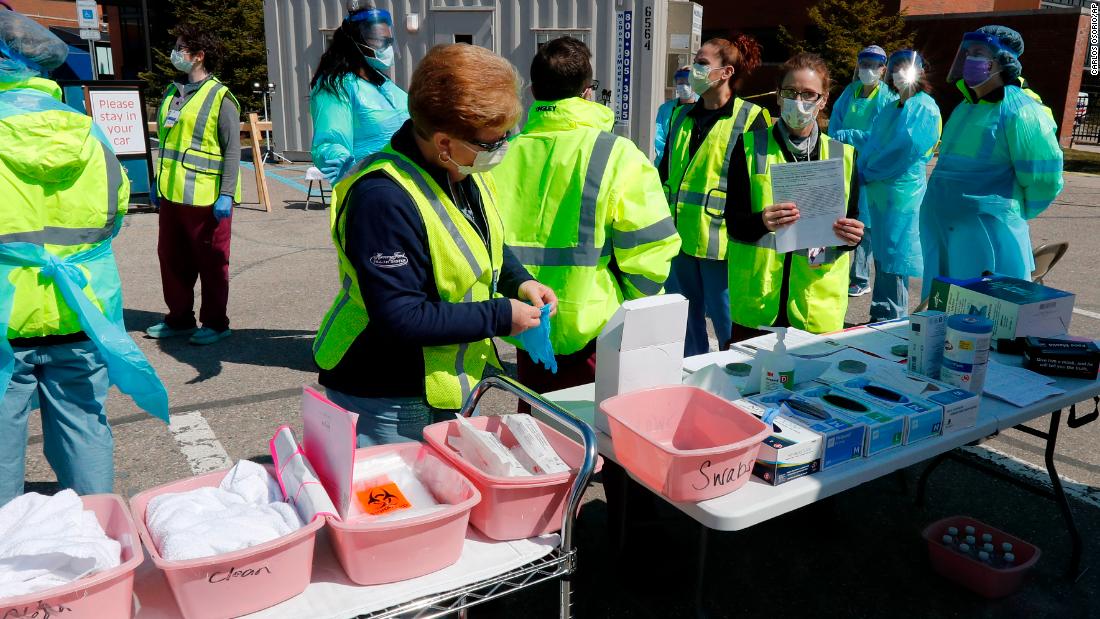[ad_1]
Chicago, Detroit and New Orleans are seeing a rapid increase of cases and health officials there are pleading for medical resources to meet the surges.
“I’ve heard of (them) putting their mask in a paper bag … and taking it out when they think they have a patent who has coronavirus,” Khaldun said.
“We don’t have enough masks; we don’t have enough gowns; and we need more from the federal government and others.”
For the third day in a row, health officials across the US reported a record number of deaths in a single day since the pandemic outbreak. At least 359 coronavirus-related deaths were reported Friday.
Latest developments around the country
• Hospitals are building new wards: Chicago’s Rush University Medical Center is converting a large part of its lobby into a potential ward with beds to help handle an expected surge of patients. Mayor Lori Lightfoot said the city could be expecting up to 40,000 hospitalization in the coming weeks.
New York governor: President’s ventilator tweet ‘incorrect and grossly uninformed’
Cuomo told CNN Friday that this was “incorrect and grossly uninformed.”
The state does have ventilators in a stockpile, and they all haven’t been delivered because “the hospitals aren’t at their apex” yet.
“Of course you don’t need them today. You need them when you hit the (projected) apex, which is 30,000. We’re not there yet,” he said.
Michigan hospitals preparing for ‘worst-case scenario’
A prominent Detroit-area hospital system acknowledged on Friday that it’s preparing for hard life-and-death decisions after a letter was circulated online detailing who would be able to receive lifesaving resources if there’s not enough equipment.
A spokesman for the Henry Ford Health System told CNN the “letter is part of a larger policy document developed for an absolute worst-case scenario.”
“It is not an active policy within Henry Ford, but it is part of our emergency response planning,” the spokesman said, noting none of the system’s hospitals are at capacity with coronavirus patients.
The letter, addressed to patients and their families in the event it is sent, says patients with the best chance of improving would be the first priority. It also says patients treated with a ventilator or ICU care may have those treatments stopped if they do not improve over time.
“Henry Ford is one of America’s great health care systems, and what they put out is honest,” Detroit Mayor Mike Duggan told CNN’s Jim Sciutto on Friday. “… Everybody is doing everything we can to stop it, but you would be irresponsible as a health system CEO if you weren’t planning for that eventuality.”
Cuomo: New York may be 21 days away from a peak in cases
The rate of new coronavirus cases is slowing in New York, but it still may take 21 days for the Empire State to hit the apex, Cuomo told reporters Friday in New York City.
The number of new cases is now doubling roughly every four days, down from what had been every two days, Cuomo said.
Several health officials and experts say the fight against coronavirus is still beginning.
“We are in for a bumpy ride for the next 12 to 18 months,” Dr. Ashish Jha, the director of the Harvard Global Health Institute, said Thursday. “If we are aggressive now about stopping things, shutting down, building up a test regime, we can then open up again …. and most places can go back to work.”
“But only when we are ready. And we are nowhere near ready now,” he said.
Doctors, nurses on the front lines
Responding to the rising numbers, some hospitals say they’ve reached a breaking point — both because of overworked staff and few medical supplies left.
A Long Island hospital nurse said patients were streaming in with “non-stop coughing, sweaty, fevers” and with “fear in their eyes.”
“I haven’t slept because my mind won’t shut off. I cried in the bathroom on my break, as I peeled off the PPE from my sweaty self, mask indentations on my face. I cried the entire ride home,” the nurse, whom CNN is not naming, wrote in a social media post.
In one New York City hospital, an assistant nurse manager who suffered from asthma died less than a week after testing positive for the virus.
Kious Jordan Kelly was a “beloved member” of the nursing staff at Mt. Sinai Hospital, the hospital said.
The coronavirus crisis has “turned our frontline professionals into true American heroes,” Mt. Sinai said in a statement Tuesday. “Today, we lost another hero — a compassionate colleague, friend and selfless caregiver.”
CNN’s Jacqueline Howard, Dakin Andone, Omar Jimenez, Bill Kirkos, Shimon Prokupecz, Carma Hassan and Melissa Alonso contributed to this report.
[ad_2]
Source link






